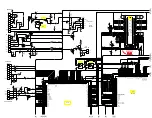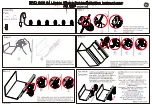
The M60 mechanic safety edge is made of a rubber elastic after shock 30mm high edge and of an alluminium
profile. The alluminium profile, which is fixed to the post, offers support to the rubber.
The electromechanical safety edge has two microswitches which guarantee its working. The first one works on
the distorsion of the rubber and of the lower part of the M60; the second one stops the automation if the steel
thread release.
INSTALLATION HEIGHT
(all measures are expressed in mm. )
HEIGHT OF EDGE ( HT )
H 1
H 2
H 3
1500
6
705
1416
1700
6
805
1616
2000
6
955
1916
2500
6
1205
2416
3000
6
973 and 1936
2916
INSTALLATION
Fix the support (A.2) on the post paying attention to the indication on the table above.
Insert the extrusion in the support and fix in the hole predispositioned (A1 ; A.3).
Set the sensitivity of the device (see Setting Instructions).
Connect the device (see Connections).
Insert the cap as shown. (A4)
SETTING INSTRUCTION
In order to modify the sensitivity of the edge do the following operations
Unblock the nut (C 1).
Regulate the sensitivity of the device by hightering the screen (C.2).
Tighter the nut (C 1).
•
In the off position do not press any microswitch.
CONNECTIONS
The M60 safety edge must be connected to a N.C. security contact. Normally you can connect it to the
infrared barrier contact if the device is fixed on the closing post, and to the “stop contact” if it’s fixed on the
opening post.
Attention: the electromechanical device M60 is an “auxiliary” safety device. The border must be used on
equipments controlled by an operator or according to the standards of the Safety Standard EN 12453.
La barre sensible M60 est composée d’un profilé en caoutchouc avec un dispositif élastique pour amortir le
choc supérieur de 30 mm et d’un profilé en alluminium que, une fois fixé au pilier, sera le support du profilé en
caoutchouc.
Le fonctionnement de la barre est garanti par deux micro-interrupteurs. Le premier intervient dans le cas où le
caoutchouc ou son support inférieur seraient déformés, le deuxième dans le cas où le petit c
â
ble en acier
perdrait de tension.
NIVEAUX D’INSTALLATION DU BORD
(Toutes les mesures sont exprimées en mm. )
H BORD ( HT )
H 1
H 2
H 3
1500
6
705
1416
1700
6
805
1616
2000
6
955
1916
2500
6
1205
2416
3000
6
973 et 1936
2916
INSTALLATION
Fixer la plaque (A2) sur le montant, suivant les niveaux du tableau ci-dessu.
Insérer le bord sensible et le fixer en utilisant les trans préparés (A1 ; A3).
Tarer le bord sensible (voir Tarage).
Connecter le dispositif (voir Connexions).
Insérer le couvercle selon le dessin. (A4)
TARAGE
Afin de modifier la sensibilité du bord agir selon les instructions suivantes
Débloquer le contre-écrou (C1).
Regulier la sensibilité du bord en agissant sur le vis qui tend le cable (C 2).
Ri-bloquer le contre-écrou (C1).
•
En position de repos pas de micro-interrupteur doit
ê
tre appuyé.
CONNEXIONS
Le bord sensible M60 est préparé pour la connexion à un contact de s
û
reté N.F. Dans la plus part des
installations le bord sensible est relié en série au contact de cellule photo-electrique s’il est placé sur la
colonne de fermeture, ou bien au bouton de stop s’il est placé sur la colonne d’ouverture de la grille. (
Attention : le dispositif pour relèvement des obstacles M60 est un dispositif de sécurité
supplementaire. Le bord sensible doit être utilisé sur des équipements contrôlés par un opérateur ou en
conformité à la Norme de Securité EN12453.
ELECTROMECHANICAL
OBSTACLE-SENSING DEVICE
FAAC M60
DISPOSITIF ELECTROMECANIQUE
POUR RELEVER LES OBSTACLES
FAAC M60




















